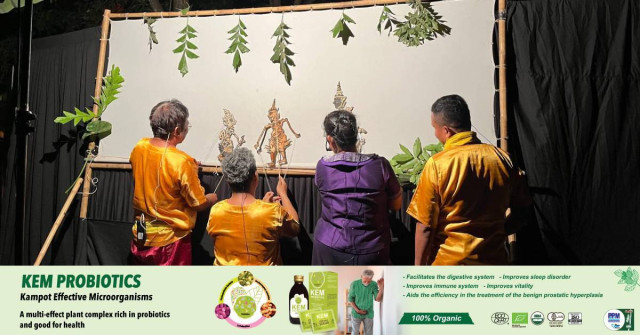Sbek Touch Theatre: Darkness, Light and Shadows

- By Torn Chanritheara
- April 13, 2024 7:14 PM
PHNOM PENH – As the sky goes dark, two puppets appear behind a white curtain hanged by two posts and lighted by bulbs while the traditional music of a Pinpeat group is heard in the night. Later on, more and more puppets would take the stage, exchanging words in front of the excited and attentive crowd. This is Sbek Touch Theatre—Khmer small shadow theatre.
That evening, the performance was due to start at 6 pm. But by that time, the most important component was missing: the darkness. As the organizer said, the sky that normally gets dark by then was not dim enough for the show, which must be performed at night. So the audience sitting on mats was told to please wait.
The wait was still going on when the cicada cried out loud at the open-air venue of the Svay Chrum Theater in Arey Ksat Town, just a short ferry travel from Phnom Penh, where the lives of the people seem to be set in the countryside. The torches surrounding the venue were lit to provide more light as people, young and old—some bringing their own mats or chairs—were flocking to Khmer Art Action where the performance was about to be staged.
The wait was soon over as the sky was now gloomy. The sound of cicada stopped just in time and the show finally started about 30 minutes late.
The night was hot and the summer heat was felt by the audience. But peoples’ eyes were fixed on the white curtain where shadows of small puppets made of leather were moved by artists and were involved in very interactive conversations, just like actors in movies, despite being disturbed by mosquitoes.
_1712895707.jpg) The performance is held at the open-air venue of the Svay Chrum Theater in Arey Ksat Town, just a short ferry travel from Phnom Penh. Photo: Torn Chanritheara
The performance is held at the open-air venue of the Svay Chrum Theater in Arey Ksat Town, just a short ferry travel from Phnom Penh. Photo: Torn Chanritheara
The performance was about the Khmer classic tale “Krai Thong and Crocodile Charavan.” Little leather characters mimicking humans or animals continued to unfold the story over more than an hour while the music of a traditional Pinpeat band was energizing the atmosphere to another level.
Suong Sopheak, president of Khmer Art Action, said that the show was the latest edition of community art performance that the organization had been hosting. As he explained, there used to be many performances in the past, but such complete staging like for this Sbek Touch performance had only been organized four times.
Chy Sophat, an online content creator who was attending the performance, said that he was thrilled to be able to watch the show with his own eyes for the first time and on such an occasion. The performance was offering a rare opportunity for many people, especially the Phnom Penh residents, to watch the show as there have been little shadow theater staged in recent years, he said.
“I’ve been in Phnom Penh for 10 years,” Sophat said. “I used to see the materials such as leathers, but this is my first time watching a performance.
“I’ve learnt about Sbek Touch and used to hear about it from older people,” Sophat said. “Now, we can know more and tell the next generation.”
_1712895858.JPG)
Darkness, shadow and light
Sbek Touch is one of the two genres in Khmer shadow theatre with the other being Sbek Thom (Khmer larger shadow theatre) to be inscribed on the UNESCO List of Intangible Cultural Heritage in 2005.
Shadow theater—a masterpiece of Khmer art known for storytelling—originated in the 1st century and, according to the Ministry of Culture and Fine Arts, was influenced by India.
While Sbek Thom shadow theatre is strictly to perform the Reamker—Cambodia’s version of India’s Ramayana—which is an ancient mythical legend that is traditionally revered and presented only during religious ceremonies, Sbek Touch features stories inspired by Khmer’s folktales, people’s livelihoods or other purposes.
Both are shadow plays and performed in the dark or at night in an open field, either farming fields or on pagoda grounds. Each leather puppet is carved from the skins of large animals such as cows or buffaloes that are more resilient and durable. They are painted according to their purpose and appearance in performances. Then each leather puppet is attached to two bamboo sticks so that it can be held and moved when performing.
Unlike Sbek Thom, in which each puppet is one piece of leather with no moving parts, a Sbek Touch puppet is manipulated with sticks and its limbs are movable, making the scenes livelier than in Sbek Thom. For Sbek Touch, the pieces of leather are shaped into human characters, trees, animals and items according to the story that will be performed.
In the past, fire was used to light the white cloth hanging across the stage; people used torches or burn palm fronds to make the fire. Today, light bulbs or LCD projectors are used to project the shadows on the white curtain.
_1712895999.jpg) Suong Sopheak uses his house in Svay Chrum commune to hold the community art performances whose aim is to promote Cambodia’s arts among the local people, especially the younger generation. Photo: Torn Chanritheara
Suong Sopheak uses his house in Svay Chrum commune to hold the community art performances whose aim is to promote Cambodia’s arts among the local people, especially the younger generation. Photo: Torn Chanritheara
Promoting lesser-known artforms
Sopheak uses his house in Svay Chrum commune to hold the community art performances whose aim is to promote Cambodia’s arts among the local people, especially the younger generation, he said. However, there are more people from Phnom Penh who come to watch the shows than local people.
Asked how he explains this, Sopheak replied that “there are few performances in the country and even in the capital. It’s good that they come. People want to see more [theatre].”
The first performance staged was Sbek Thom, the second was mixed arts, and the third one was Yike, a form of theater with singing and dancing that is less and less performed in the country.
“We’ve staged all forms of Khmer arts,” he said. “We are looking at some of the forms that have almost disappeared and re-stage them such as Ayai and other the lesser-known theatre forms.”
As Sopheak stressed, the purpose of these community art performances is to raise awareness about culture and tradition among Cambodians. Children are easily fascinated by a Sbek Touch performance as it features daily-life activities, he said.
While for Sbek Thom, the narrator usually follows the script, Sbek Touch artists casually speak with one another, using simple words and, from time to time, include humor, making it easy for children to understand and follow the story.
When there are more performances, this gives people an opportunity to know about their culture, and staging them in their community should be the starting point, Sopheak said.
Although today, people can watch art performances on their electronic devices such as smartphones, Sophat recommends coming in person and watching, which will be the best experience.
“Watching with their own eyes could bring their emotions and the acting together,” Sophat said. “It can be [the argument for] a campaign to attract younger people.”
The Khmer Art Action also holds various forms of theatre and art shows at locations in Phnom Penh as well as during events in the capital.
For more information about their performances in Arey Ksat Town and in Phnom Penh, please visit: https://www.facebook.com/KhmerArtAction
_1712896146.jpg) To revive old practice, mats are used during the performance. Photo: Torn Chanritheara
To revive old practice, mats are used during the performance. Photo: Torn Chanritheara















